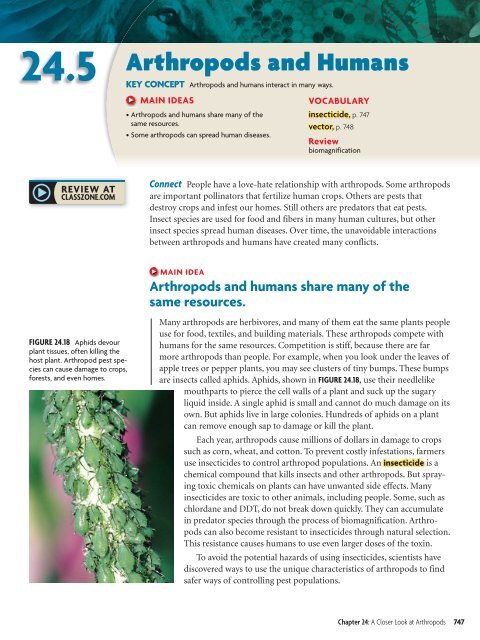24 A Closer Look at Arthropods
24 A Closer Look at Arthropods
24 A Closer Look at Arthropods
Create successful ePaper yourself
Turn your PDF publications into a flip-book with our unique Google optimized e-Paper software.
<strong>24</strong>.5<br />
<strong>Arthropods</strong> and Humans<br />
KEY CONCEPT <strong>Arthropods</strong> and humans interact in many ways.<br />
MAIN IDEAS<br />
• <strong>Arthropods</strong> and humans share many of the<br />
same resources.<br />
• Some arthropods can spread human diseases.<br />
VOCABULARY<br />
insecticide, p. 747<br />
vector, p. 748<br />
Review<br />
biomagnific<strong>at</strong>ion<br />
Connect People have a love-h<strong>at</strong>e rel<strong>at</strong>ionship with arthropods. Some arthropods<br />
are important pollin<strong>at</strong>ors th<strong>at</strong> fertilize human crops. Others are pests th<strong>at</strong><br />
destroy crops and infest our homes. Still others are pred<strong>at</strong>ors th<strong>at</strong> e<strong>at</strong> pests.<br />
Insect species are used for food and fibers in many human cultures, but other<br />
insect species spread human diseases. Over time, the unavoidable interactions<br />
between arthropods and humans have cre<strong>at</strong>ed many conflicts.<br />
MAIN IDEA<br />
<strong>Arthropods</strong> and humans share many of the<br />
same resources.<br />
FIGURE <strong>24</strong>.18 Aphids devour<br />
plant tissues, often killing the<br />
host plant. Arthropod pest species<br />
can cause damage to crops,<br />
forests, and even homes.<br />
Many arthropods are herbivores, and many of them e<strong>at</strong> the same plants people<br />
use for food, textiles, and building m<strong>at</strong>erials. These arthropods compete with<br />
humans for the same resources. Competition is stiff, because there are far<br />
more arthropods than people. For example, when you look under the leaves of<br />
apple trees or pepper plants, you may see clusters of tiny bumps. These bumps<br />
are insects called aphids. Aphids, shown in FIGURE <strong>24</strong>.18, use their needlelike<br />
mouthparts to pierce the cell walls of a plant and suck up the sugary<br />
liquid inside. A single aphid is small and cannot do much damage on its<br />
own. But aphids live in large colonies. Hundreds of aphids on a plant<br />
can remove enough sap to damage or kill the plant.<br />
Each year, arthropods cause millions of dollars in damage to crops<br />
such as corn, whe<strong>at</strong>, and cotton. To prevent costly infest<strong>at</strong>ions, farmers<br />
use insecticides to control arthropod popul<strong>at</strong>ions. An insecticide is a<br />
chemical compound th<strong>at</strong> kills insects and other arthropods. But spraying<br />
toxic chemicals on plants can have unwanted side effects. Many<br />
insecticides are toxic to other animals, including people. Some, such as<br />
chlordane and DDT, do not break down quickly. They can accumul<strong>at</strong>e<br />
in pred<strong>at</strong>or species through the process of biomagnific<strong>at</strong>ion. <strong>Arthropods</strong><br />
can also become resistant to insecticides through n<strong>at</strong>ural selection.<br />
This resistance causes humans to use even larger doses of the toxin.<br />
To avoid the potential hazards of using insecticides, scientists have<br />
discovered ways to use the unique characteristics of arthropods to find<br />
safer ways of controlling pest popul<strong>at</strong>ions.<br />
Chapter <strong>24</strong>: A <strong>Closer</strong> <strong>Look</strong> <strong>at</strong> <strong>Arthropods</strong> 747

















